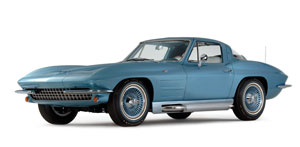
1964 Corvette Styling Car
This 1964 Corvette Coupe was specially built for the Chevrolet’s General Manager, Semon E. “Bunkie” Knudson as his personal car in September 1963. The second owner, Mr. Gailey from Chevrolet Engineering Center, purchased the car in the summer of 1964 at a special GM party where names were drawn from a hat for the right to purchase surplus engineering cars.
The car still retains the original drive train 327/365 hp engine and all of the custom parts that were added in the Styling and Engineering departments. It sports custom Cadillac Fire Frost Blue paint over a specially prepared body surface prepared by GM Styling. The hood is a special design, custom large special cast grill, unique front bumper treatment, custom high back bucket seats with an all white leather trim, with custom Cadillac carpeting, special toe board stainless polished grates, one-off door panels with power windows and power vent wings. Mitchell’s influence again appears with the stunning custom side pipes that share design characteristics of both 1965 and 1969. The telescopic steering column is an engineering piece, all hand made and pre-1965 production sporting many hand made parts unique to this car. The car retains its original Engineering Department tag located next to the VIN tag under the glove box.
Then Chief Engineer, Zora Duntov knew what a highly successful international sports car needed in order to be competitive, while GM Vice President of Styling William Mitchell, who had replaced Harley Earl in 1958, had an incredible eye for design. (It was Earl, with his flashy post war designs, who had changed corporate thinking, that styling played a more important role than did
Engineering.) Although, this would normally be the makings of success, they kept tripping over there own egos. They were both right, yet they put the blinders on when it came to seeing and understanding each other’s position. Duntov usually came out on the short end of the stick, as Mitchell being a VP, held all of the clout. “Engineering never sold a goddamn thing” Mitchell was overheard to say one day while yelling to Duntov, making his feelings clear that the tail would be wagging the dog if engineering determined how the cars look.
Valued at: $1,000,000